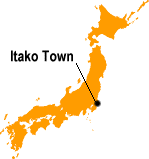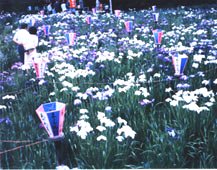

 |
||

|
Famous for its Irises: A Shipping Port
that Flourished in the Edo Period
 Itako Town in Ibaraki Prefecture lies beside the Tonegawa,
the river with the largest catchment area in Japan. During the Edo
period (1603-1868) it flourished as a relay port for the shipment of
cargo from the north of Japan by water to the nation's capital, Edo. The
beautiful scenery on the waterfront was much admired by writers and artists,
many of whom visited the town. A frequent visitor to Itako was Ujo Noguchi
(1882-1945), a poet born in Ibaraki, who wrote many famous folk songs and
songs for children. Through his songs, he presented his vision of Itako
to people all over Japan of the Tonegawa majestically flowing by.
Today, the Ayame (iris) Festival in June is the biggest tourist attraction. Along the sides of the river iris flower park has been set up, and as the season approaches, as many as one million individual plants of around 500 colorful varieties come into bloom in purple, white and yellow. During the festival season every year the town attracts about half a million visitors. Boatmen ply the waters in rowboats, taking sightseers on trips redolent of the past. If you are lucky, you might be able to see a beautiful bride going out to meet her bridegroom on one of these boats. In 1981 it was discovered that six white swans had come to winter in Lake Kitaura, which lies to the north of Itako Town. Around 60 swans now fly in to pass winter from mid-November to mid-March, and their graceful presence has become a new waterside attraction in Itako Town. Photos: (Top) Iris Festival at Itako Municipal Maekawa Iris Garden; (middle) a rowboat carrying a bride in a traditional costume. (Ibaraki Prefecture) Unauthorized reproduction of the
photos in this page is prohibited.
Related Links: |
|

